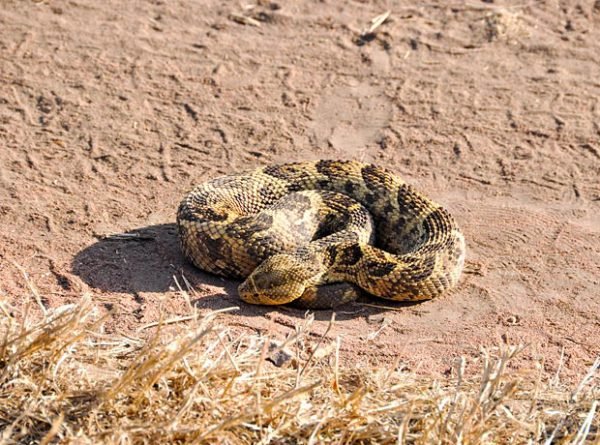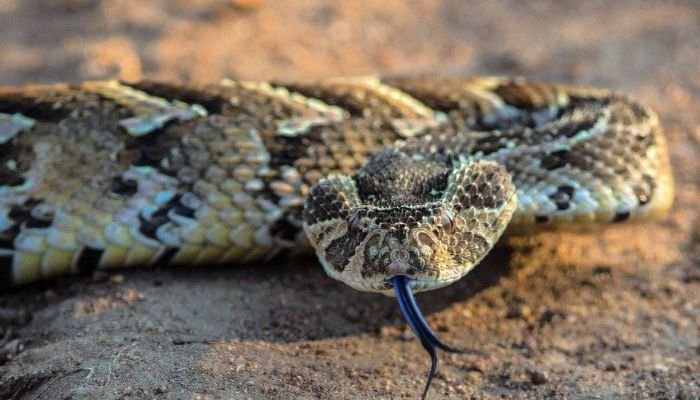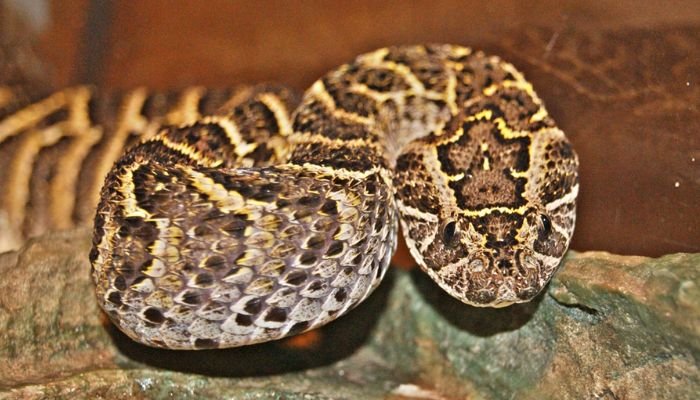
The puff adder is the common name for Bitis arietans, a species of venomous snake found in sub-Saharan Africa. Due to its sturdy body, unusual triangular-shaped cranium, and camouflaged coloring, the Puff Adder is an expert at ambush predation. It preys on small mammals, birds, and reptiles and lives primarily on land. The Puff Adder, despite being sluggish and calm, has potent venom and is responsible for numerous snakebites in Africa.. Here are Puff adder Guide on Food, Habitat, Size, Lifespan & Predators below-
Puff adder Stats in Table format
The stats are given below for Puff adder
| Reptiles List | Puff adder |
|---|---|
| Family | Viperidae |
| Type | Snake |
| Size | Medium |
| Length | Puff adder: Up to 3-5 feet (0.9-1.5 meters) |
| Color | Puff adder: Usually has a brown or gray coloration with darker markings. |
| Weight | Puff adder: Can weigh between 2 to 5 pounds.. |
| Lifespan | 10-15 years (or more) |
| Reproduction | Ovoviviparous, gives birth to live young |
| Gestation Periods | Gestation period of a puff adder is approximately 3-5 months. |
| Endangered Status | Least Concern (IUCN Red List) |
| Features | Venomous bite, heat-sensing pits on face |
| Country & Areas | Africa, including countries such as South Africa, Namibia, Botswana, Zimbabwe, Mozambique, and many others. |
Puff Adder Natural Habitat and Distribution
Because of their versatility, puff adders can be found in a wide range of ecosystems, from grasslands and savannas to forests and semiarid zones. They thrive in regions teeming with rodents since such animals make up a sizable portion of their diet. Puff adders also prefer habitats that provide them with safe places to relax and ambush their food, including areas with plenty of burrows and crevices.
South Africa, Namibia, Botswana, Zimbabwe, Mozambique, Zambia, Angola, Kenya, Tanzania, and a plethora of other African countries are all included in their range. Because of their versatility and widespread range, they are one of Africa’s most common venomous snakes.
Puff Adder Physical Features and Adaptations
Here are some information about Puff Adder Physical Features and Adaptations
1. Body Structure
Female puff adders tend to be larger than males, but both sexes are stocky and strong. Some may grow even larger than this, but on average they can reach lengths of roughly 2 to 4 feet. Their large, flat, triangular heads set them out visually. These snakes use their deadly venom and strong fangs to paralyze their prey.
2. Coloration and Patterns
Puff adders’ ability to blend into their environments is greatly aided by the camouflage provided by their coloring and patterning. They feature a sequence of black, zigzag-like markings over their back, and their base color can range from very light yellow to light brown or reddish brown. This pattern helps them blend in with the underbrush, making them less of a target for predators.
3. Defense Mechanisms
Puff adders have a well-deserved reputation for being fiercely protective of themselves. When they feel threatened, they may hiss loudly, puff out, and assume a coiled position to make themselves look bigger and scare away their enemies. They have an effective line of protection against predators and other dangers thanks to their venomous bite.
Puff Adder Diet and Feeding Habits
Here are some information about Puff Adder Diet and Feeding Habits
1. Diet Type
Puff adders are ambush predators that rely heavily on a waiting game to bring down their victim. Because of their carnivorous nature, they eat things like rodents, birds, and even frogs occasionally. Because of their slow metabolism, they only need to eat a few times a day to stay alive.
2. Preferred Food Sources
Because of their opportunistic nature, puff adders will eat any food source presents itself to them. Because of their specific diet, they are very useful in agricultural areas for reducing rodent populations.
3. Feeding Schedule
Puff adders’ low metabolic rate means they can go longer between meals. Depending on the size of their last prey, they may go weeks without meals. It’s normal for people to slow down after eating a big meal so their bodies can focus on digesting.

Puff Adder Housing and Enclosure Requirements
Here are some information about Puff Adder Housing and Enclosure Requirements
1. Terrarium Size and Setup
Puff adders kept as pets require a large, well-protected enclosure. The snake’s enclosure needs to be big enough so it can walk around freely and provide it with hiding places like it would in the wild. The terrarium should have a tight-fitting lid to keep the inhabitants inside.
2. Substrate Options
The puff adder will feel more at home in an environment that mimics its native habitat by using a substrate made of sand, soil, or bark. The snake needs a deep enough substrate to dig into and use as cover.
3. Temperature and Lighting
Puff adders can’t adequately regulate their body temperature without a temperature differential within their enclosure. The basking side of the enclosure should be between 85 and 90 degrees Fahrenheit, while the other side can be cooler, between 75 and 80 degrees. It’s critical to supply a heat source, either an under-tank heating pad or a heat lamp. To create a day-night cycle, proper lighting is also required.
4. Humidity and Water Needs
Puff adders require stable humidity levels (between 50 and 60 percent) for skin shedding and general hydration. To guarantee that they always have access to clean water, a shallow dish can be left out.
Puff Adder Behaviour and Temperament
Here are some information about Puff Adder Behaviour and Temperament
1. Activity Levels
The majority of a puff adder’s activity, including foraging and mating, takes place after dark. They typically avoid the heat of the day by hiding in cool places like burrows, cracks in rocks, or thick vegetation.
2. Social Behaviour
Puff adders are solitary creatures who like to be left alone to live out their days. During mating season or during hunting, they could come into contact with other individuals.
3. Handling and Taming
Due to their venomous nature and protective tendencies, puff adders are not suitable as pets. Only trained professionals, such as herpetologists or poisonous snake handlers, should attempt to handle a venomous snake.
Puff Adder Breeding and Reproduction
Here are some information about Puff Adder Breeding and Reproduction
1. Mating and Courtship Rituals
Male puff adders are quite busy during the mating season. In order to win the opportunity to mate with a female, they may participate in ritualized battle with other males. After a man has courted and won the affections of a woman, the two of them will engage in copulation, which can last for hours.
2. Incubation and Hatchlings
The female puff adder will mature and lay eggs after a successful mating. The average clutch size is between 20 and 40 eggs, but this number can vary. Once the eggs are laid, the female will leave them to incubate in the warm surroundings. The eggs will hatch after around three to four months of incubation, and baby snakes will look just like their parents.
Puff Adder Common Health Issues and Veterinary Care
Here are some information about Puff Adder Common Health Issues and Veterinary Care
1. Respiratory Infections
Puff adders are susceptible to respiratory illnesses, as with many other reptiles, if maintained in unsuitable settings. Breathing through the mouth, wheezing, and excessive mucus production are all symptoms of respiratory problems. Seeing a vet right away is crucial if any of these signs are noticed.

2. Parasites:
Puff adders can be affected by both internal and external parasites. To preserve the snake’s overall health, it is important to take it in for regular checkups so that any parasitic infections can be identified and treated.
3. Metabolic Bone Disease
Puff adders in captivity are susceptible to metabolic bone disease (MBD) if they are not given access to UVB lighting and a calcium-rich diet. Bone weakness and abnormalities caused by MBD can have a devastating effect on a snake’s quality of life.
Importance of Regular Vet Check-ups
The health of captive puff adders relies heavily on routine veterinarian examinations. A qualified veterinarian can determine the general health of your reptiles, identify any problems, and advise you on how to best care for them. The quality of life for these reptiles can be greatly improved with early intervention and preventative measures.
Conclusion
Puff adders, in conclusion, are fascinating reptiles that may be found all over sub-Saharan Africa. The ecosystem benefits from its capacity to adapt, its unusual colour, and the fact that it is poisonous. This intriguing animal is best appreciated at a safe distance in the wild, but efforts to develop suitable captive settings and offer proper veterinary care can contribute to its conservation. A greater appreciation for the fragile balance of the natural world and the necessity of preserving biodiversity for future generations can be cultivated via learning about and reflecting on the puff adder’s function in its natural habitat.
FAQs
Q: What is the family and Type of a Puff adder?
A: The Puff adder is a species of the family Viperidae. The Famous Puff adder is a member of the family Snake.
Q: What is the average size of a Puff adder?
A: The average adult Puff adder is Medium between Puff adder: Up to 3-5 feet (0.9-1.5 meters).
Q: How long can a Puff adder grow in size in lengths?
A: Puff adder is Medium in size and The puff adder is a snake species that can grow up to 3-5 feet in length, which is approximately 0.9-1.5 meters.
Q: What colors do Puff adder come in?
A: The puff adder is typically characterized by its brown or gray coloration, adorned with distinct darker markings..
Q: How big can a Puff adder get in weight?
A: The puff adder is a snake species that typically weigh between 2 to 5 pounds.
Q: What are the special Features of a Puff adder?
A: Puff adder are Venomous bite, heat-sensing pits on face
Q: How long do Puff adder live?
A: The usual lifespan of a Puff adder is The lifespan of a Puff adder is typically around 10 to 15 years, although some individuals may live even longer.
Q: What food does the Puff adder eat?
Small mammals like rats and rabbits make up the bulk of the puff adder’s food. Birds, lizards, and even other snakes have been found in their stomachs. Puff adders are patient ambush predators that strike with their poisonous fangs when their prey is within striking distance. They can go for lengthy periods of time without eating because their metabolism is so sluggish.
Q: What is the best habitat for an Puff adder?
Answer: A Puff adder is most at home in Africa’s savannas, grasslands, and semi-arid environments. Venomous snakes like these tend to congregate in regions with plenty of tall grasses and shrubs to hide and prey in. They have also been found in stony places and dried riverbeds. As long as there is enough food, puff adders can make do in a number of different environments, from deserts to woods. They are ambush predators who use their camouflage to sneak up on their prey and surprise it. Because of how effectively they adapt to their native settings, puff adders have been able to keep their numbers up.
Q: How do Puff adder give birth?
A: Puff adder are Ovoviviparous, gives birth to live young
Q: How long is the gestation period for an Puff adder?
A: The gestation period of an Puff adder is approximately Gestation period of a puff adder is approximately 3-5 months.
Q: What is the natural behavior of an Puff adder?
Most puff adders are female, hence the answer is Puff adders are venomous snakes native to Africa, and they display a wide range of behaviors in the wild. It is nocturnal, spending the daytime hours hiding in the shadows or underground. It reacts to danger by puffing itself up, hissing loudly, then striking with devastating speed. It ambushes its victims, primarily birds and small mammals, by hiding in plain sight until the perfect moment to strike. The puff adder has a reputation for being defensive and will bite if it feels threatened. Usually reclusive, it only interacts with others during mating season. The puff adder’s natural activity is often geared around these three basic needs in its native environment: survival, hunting, and reproduction.
Q: Is the Puff adder endangered?
A: The Puff adder is Least Concern (IUCN Red List).
Q: What are the prey of Puff adder?
A: Small mammals, birds, lizards, and frogs are the prey of the puff adder..
Q: Do Puff adder have any Predators?
Puff adders, the answer Puff adders have several predators, including larger animals like mongooses and honey badgers, as well as birds of prey like eagles and hawks. Puff adders are easy prey for these predators because of their excellent eyesight and scent. They employ their quick reflexes and strength to overcome the snake, often aiming for its head to escape its poisonous fangs.
Q: How Fast Does Puff Adder Move?
A: The puff adder can move at speeds of up to 8 miles per hour, making it one of the fastest-moving snakes in the world.
Q. What is Bite Force of Puff adder in PSI?
A. Bite Force of a Puff Adder is around 100 PSI.
Q: Can we keep Puff adder as pets?
Puff adders cannot be kept as pets, according to the experts. They are extremely hazardous venomous snakes that are found in Africa. Their venom is extremely lethal and can result in life-threatening injuries. Keeping them as pets violates the law and puts you at risk.
I hope you like reading on Puff adder FAQ Guide on Food, Habitat, Size, Lifespan and Predators.
